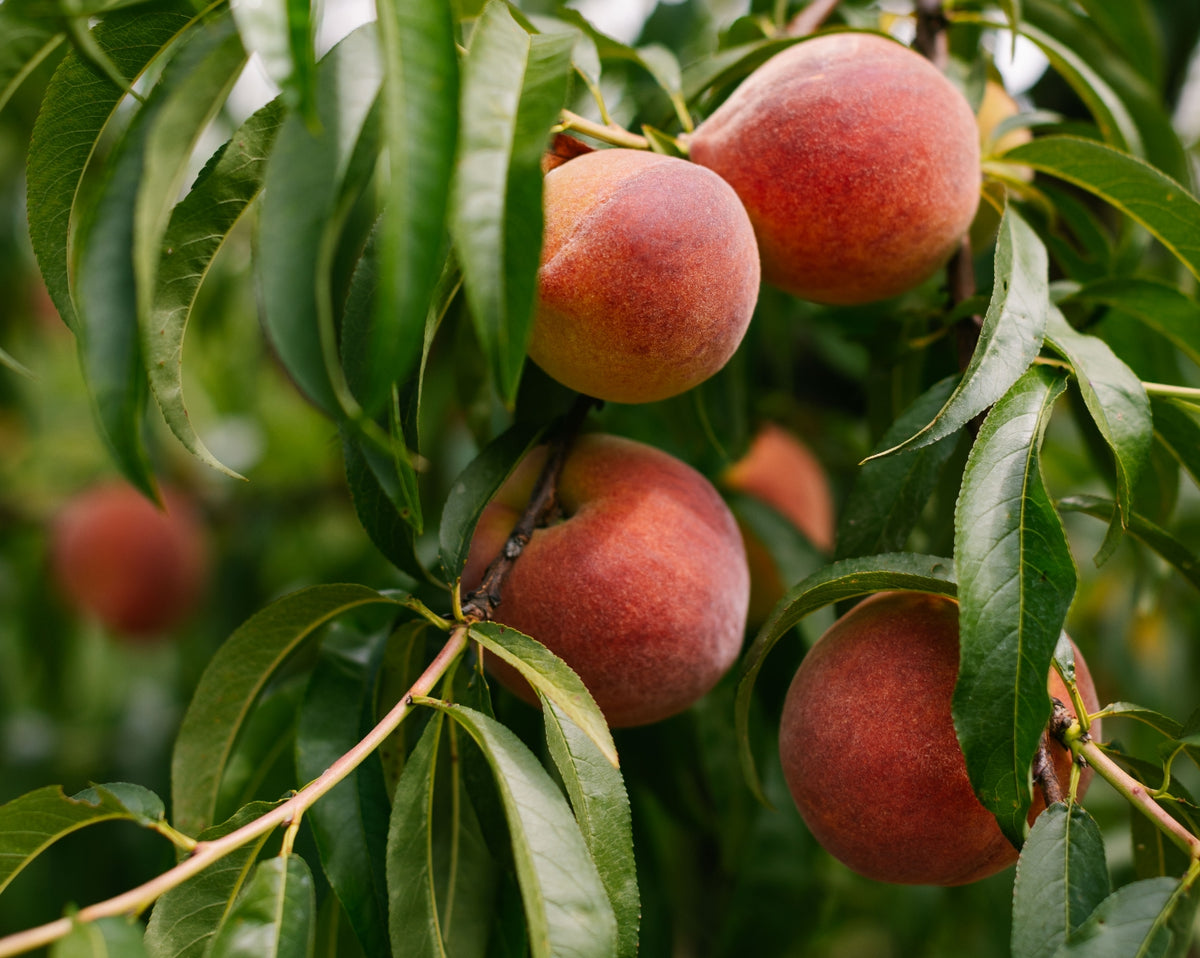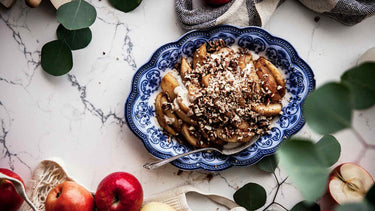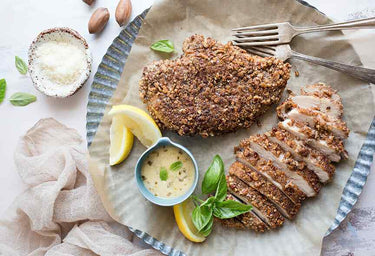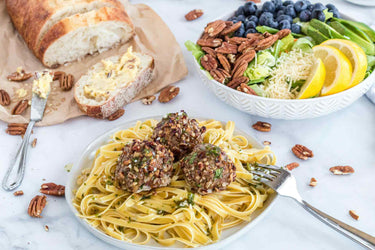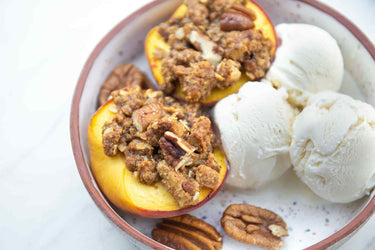

Peaches 101

OUR PEACH GUIDE
Everything you’ve ever wanted to know about peaches.
Wish you knew more about George’s namesake fruit? Then you’ve come to the right place. We’ll teach you the difference between freestone and cling, when each of our varieties are perfectly ripe for the picking, and which peach is best for your favorite recipe.
Learn how Georgia’s red clay feeds our trees, how honeybees help our crop, and how we harvest our peaches for peak flavor and texture.
1. Clingstone Peaches
As the name implies, the flesh inside a clingstone peach clings to the pit, making it slightly challenging to remove. However, with the proper slicing technique, you can easily separate the pit from the flesh. Clingstone peaches make up for their tight grip by having a sweeter, softer and juicier flesh than freestone peaches.
Their delicious flavor and delicate texture make them ideal for baking, canning and preserving in jellies or jams. They’re also perfect for eating fresh off the tree! Most grocery stores carry freestone peaches, so you’ll have to venture to your local orchard or farmer’s market for this summertime treasure.
2. Freestone Peaches
When you cut a ripe freestone peach in half, the pit will easily pull away from the flesh. Some people prefer cooking with freestone peaches because they're easier to prepare. The pit virtually falls out when you cut them. Freestone peaches are often larger and have a firmer texture. They're less juicy than their clingstone counterparts, but they're still juicy and delicious. Freestone peaches have the perfect balance of sweetness for making sugary desserts. You can eat them fresh or use them in baking, freezing and canning.
3. Semi-Freestone Peaches
Semi-freestone peaches have a similar sweetness and texture to a clingstone peach with a pit that is easy to remove, like a freestone peach. This hybrid is perfect for almost any recipe. Semi-freestone peaches are great for baking, canning, preserving, cooking or eating fresh from the farm. When shopping for semi-freestone peaches, you might also find them labeled as semi-clingstone, semi-free or semi-cling.

White vs. Yellow Peaches
Hundreds of peach varieties grow in America, but most of them have either yellow or white flesh. Different colors have unique flavors and consistencies. Choosing the right shade is key to making tasty recipes that will leave you wanting more. Here’s what you should know about yellow and white peaches:
1. White Peaches
Primarily grown in Asia, delicious white flesh peaches have migrated to American orchards. From the outside, their light reddish-yellow skin is less orange than a yellow peach. Inside, their flesh is typically pale white or light yellow with pink streaks near the pit. White peaches are the sweetest of the two colors because they have a higher sugar content and lower acidity. While their delicate flesh is too soft and smooth for baking, it’s perfect for grilling or enjoying raw.
2. Yellow Peaches
Yellow flesh peaches are the epitome of summer. They're more common and easier to find than white flesh varieties. As their name implies, the flesh inside is a warm yellow with red streaks around the center. When you take a bite of a yellow flesh peach, the sweet, fruity flavor is balanced with a hint of acidity. Yellow peaches have a sugary tang that pairs perfectly with savory recipes, salad dressings and desserts. The intense flavor and firm texture make yellow peaches great for baking.

Find the Best Peaches
for Your Needs
Which Peaches Are the Sweetest?
With hundreds of varieties to choose from, choosing the sweetest peach is like finding a needle in a haystack. Some varieties are naturally sweeter than others, but their ripeness level also makes a difference. Peaches have natural sugars that create their hallmark sweetness. They also contain acid that forms a sour tang. The balance of sugar and acid determines the fruit’s flavor. Peaches with high sugar content and low acidity will taste the sweetest.
White peaches have a low acidity level and are known for their sugary sweetness. Donut peaches are small, squished-looking fruits that some people consider the sweetest of all. They come in white-fleshed varieties that are soft, juicy and super sweet. Other contenders for the sweetest peach are Redhaven, Red Globe, Polly and Elberta varieties. Any of these options are sure to satisfy your sweet tooth.

Which Peaches Taste Best?
The first bite of a freshly ripened peach is undeniably sweet and refreshing. However, everyone’s taste buds are different, so each person will have a unique experience tasting the same fruit. The best-tasting peach depends on your flavor preferences. Yellow-flesh varieties are known for having a classic Southern peach flavor. Though white peaches are becoming increasingly popular for their pronounced sweetness.
Enjoying peaches at peak ripeness will ensure you taste the best flavor possible. Look for these signs that your peaches are ripe:
Color: A ripe peach will have a deep reddish color on the side where the sun could reach. Peaches with dark spots and bruising are overripe. If there are green areas, the peach was harvested too early.
Firmness: Gently squeeze the peach. It should be slightly soft without bruising or denting. If the peach feels hard, it’s underripe.
Scent: Peaches emit a sweet aroma when they’re ripe. Give your peaches a sniff. If you notice a sweet, peachy scent, it’s time to enjoy them. No smell means the peaches need a few more days to ripen.

Which is the Best Peach for Eating Whole?
Eating a peach whole can be messy depending on which kind you choose. If you’ve got a napkin nearby, you can enjoy any peach whole. If you want to avoid dripping in sticky peach juice, look for varieties that aren’t as soft and moist. Yellow freestone peaches are delicious and easy to eat whole since they have a firm texture and slightly less juice. The pit comes right out, so you can safely enjoy the entire fruit.

Which Peaches are Best for Baking?
If you like to bake your peaches into warm, comforting desserts, look for yellow freestone peaches at your local orchard or farmer’s market. Yellow peaches have a sweet and tangy flavor that balances out sugary baked goods. Their naturally firm flesh bakes to a soft — but not mushy — texture.
Redhaven, Glohaven or Cresthaven peaches are all great options. They’re perfectly sweet and resistant to browning for desserts that look and taste beautiful. The pit pops right out, making preparation a breeze. If you prefer the flavor of a clingstone peach and don’t mind the extra prep work, you can remove the pit with a few strategic cuts.

Which Peaches Are Best for Canning or Preserving?
When choosing peaches for canning or preserving, it’s important to consider which method you’re using. Some people like to can sliced peaches in a light syrup, while others preserve homemade peach jam. Consider the best peaches for your recipe:
Sliced peaches: Freestone peaches are ideal for canning. The pit comes right out without damaging the surrounding flesh so you can make precise cuts. The flesh is resistant to browning, so your slices look beautiful inside the jar. You can still use clingstone peaches for canning, they just take longer to prepare.
Peach jam: Clingstone peaches are the best option for making jam. Their extra-sweet flavor and soft texture create a delicious fruity spread. The soft flesh cooks down into a smooth jelly, so making several cuts to remove the pit won’t hurt the finished product.
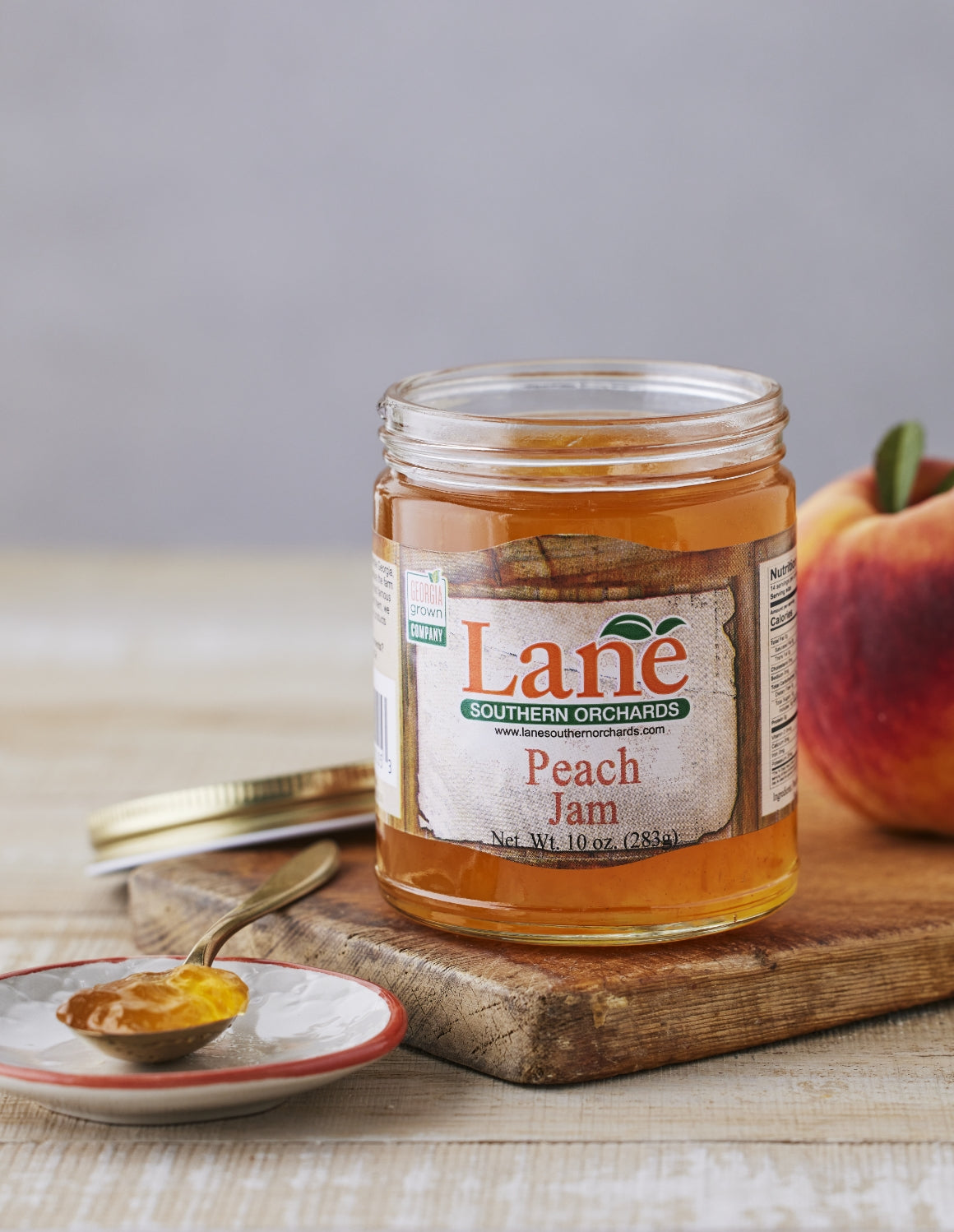
Which Peaches Are Best for Cooking?
Any fresh, local peach will make an excellent addition to your cooking if you’re in a pinch. However, choosing the right peach can take your recipe to the next level. The ideal variety depends on the flavors in your dish. Georgia peaches pair perfectly with sweet and savory meals.
The sweet and tart flavor of a yellow flesh peach pairs well with many other foods. If you’re making a fresh salad, mix in some ripe peach slices and a drizzle of cilantro peach vinaigrette for a fruity twist. Yellow peaches also pair perfectly with meat and cheese in a summer-inspired charcuterie board.
If you prefer sweeter dishes and desserts, white flesh peaches are the better choice. Put a Southern spin on a breakfast classic by adding sliced peaches to your homemade pancakes. Soft peaches pair perfectly with the fluffy flapjacks. You can also top off your fruity stack with a Southern peach syrup that ties the flavors together.
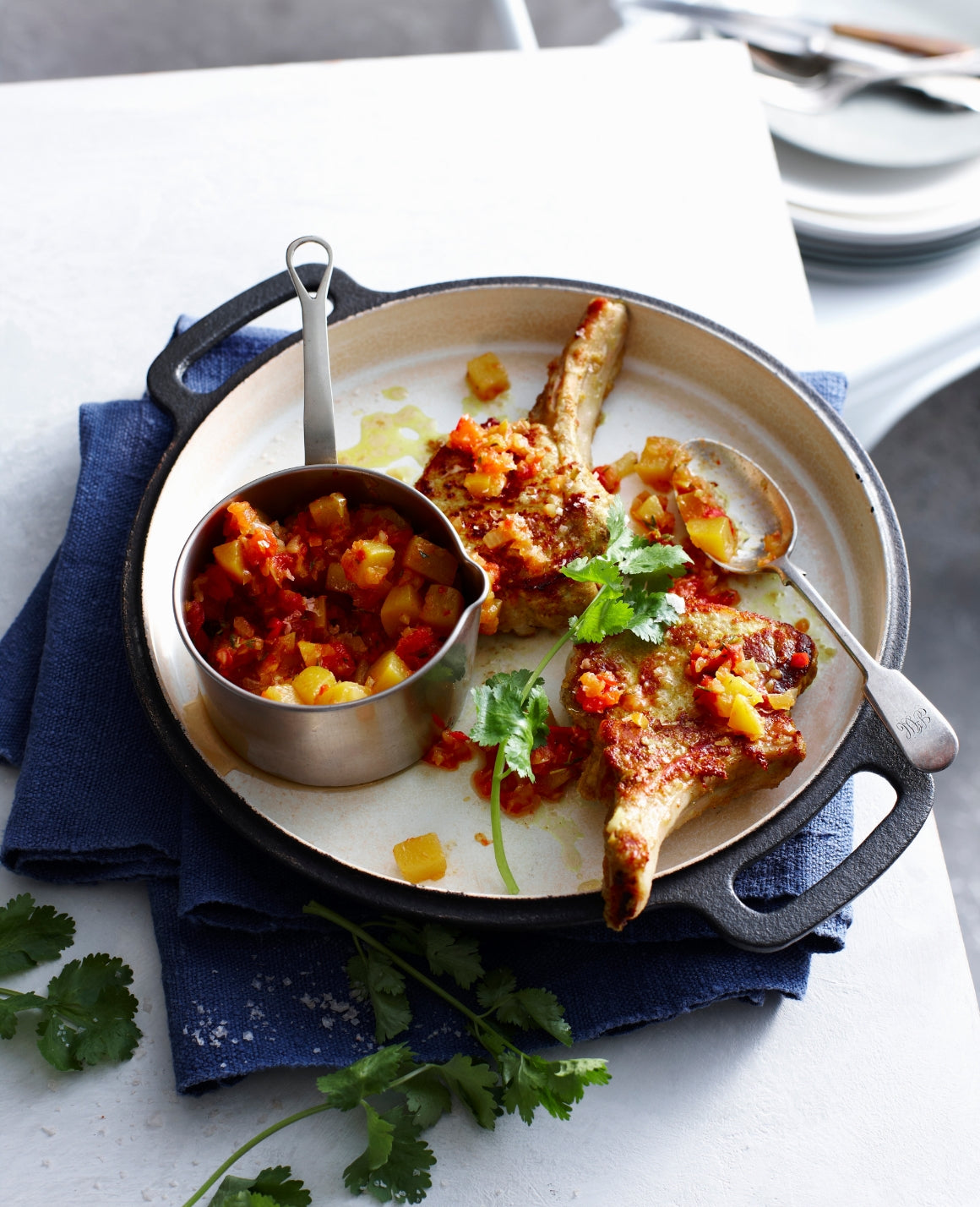
What Kind of Peaches Should I Freeze?
You can freeze any peaches you like. It’s one of the easiest methods to preserve your summertime bounty. Once they’re frozen, you can use them for fruit smoothies, baking or your favorite recipes. Peach ice cream is a delicious summertime treat you can make with the thawed peaches.
Blanching your peaches for a few seconds in boiling water and transferring them to an ice bath makes it easy to remove the skin before freezing. Tossing them with a dash of lemon juice will prevent them from browning. Freeze your peaches for a few hours on a sheet pan before transferring them to an airtight, zip-top plastic bag. Frozen peaches will last up to a year.

Which Peaches Are Best for Children?
Are your kids picky eaters? If your children are sensitive to flavors and textures, look for peaches that are sweet and smooth. The soft, fuzzy skin of a classic peach might seem strange to young kids. Nectarines are a type of peach with the same delicious taste but without the fuzz. They come in many different varieties. A white-flesh, freestone nectarine will have an extra-sweet taste with a pit that kids can easily remove.
If you prefer traditional peaches, you can remove the skin or scrub off the fuzz by hand.

Which Peaches Make the Best Drinks?
Soft Georgia peaches blend smoothly into delicious fruity beverages. Any ripened peaches will work, but some varieties can take your drink recipes to the next level. Freestone yellow peaches have a hint of sour tang for making the best cocktails. Blend them with some tequila and ice for the perfect, juicy peach margarita.
Peaches also make a great addition to a breakfast smoothie. Clingstone peaches are soft and juicy, which makes them slightly easier to blend than freestone varieties. Combine fresh or frozen peach slices with any other fruits you like for a delicious and nutritious drink. Add milk or juice, yogurt and ice to achieve a smooth, frosty texture.
After dinner, you can unwind with a creamy peach milkshake. Mash some soft, fully ripened peaches with vanilla ice cream and a splash of milk. If you like your milkshake extra sweet, use white clingstone peaches. If you prefer a balanced, tangy flavor, use freestone yellow peaches. Regardless of which peaches you choose, you’re sure to enjoy this decadent peach dessert.

Where Can I Buy Fresh Local Peaches?
Lane Southern Orchards is the place to go for fresh Georgia peaches from mid-May through August. Our roadside market is full of over 35 varieties of peaches you can buy within hours of being picked. Located in the heart of Georgia, we’ve been growing peaches for over 100 years. We take pride in providing the best of Georgia from our farm to your family.
During your visit to Lane Southern Orchards, you can enjoy more than fresh, local peaches. We also offer farm-fresh treats like homemade peach ice cream and smoked pork barbecue. Stroll around our roadside market for peaches, pecans, strawberries and other freshly picked produce. You’ll also find garden-fresh jams, jellies, dressings and salsas to stock up your pantry. Our products make great gifts!
Stop by the farm this summer for some juicy, Georgia peaches. We also ship our fresh, seasonal peaches so everyone can enjoy premium Southern produce. In the meantime, you can shop online for delicious peach products year-round.
Try Some Homestyle Southern Recipes
Since 1908, Lane Southern Orchards has been growing peaches and pecans continuously for over 100 years!
We love opening our farm to building memories and stories that last a lifetime. Contact Wendy or call us at 1-800-27PEACH to schedule your party or event!


